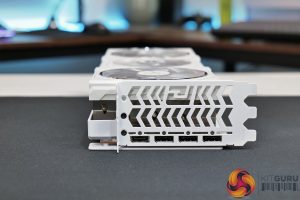The PowerColor RX 7900 XTX Hellhound Spectral White ships in a light grey, almost white box – clearly in keeping with the Spectral White theme. The Hellhound logo takes pride of place on the front, while PowerColor highlights various key features of the card and cooler in the box.
Inside, the only included accessory is a GPU support holder, designed to take some weight from the PCIe slot to prevent unwanted sagging.
In terms of the card itself, clearly the focus is on the all-white aesthetic, which extends from the shroud to the backplate and even the PCB. Undoubtedly this will come down to personal preference – but I really like the look, it’s very clean but also more eye-catching than the usual black rectangular slabs we get for review.
The shroud itself is made from plastic and not metal, which I was initially disappointed by but it still feels reasonably solid in the hand, and I guess it will help keep the weight down too.
Speaking of weight, the Spectral White tipped the scales at just over 1.5KG, so it’s pretty hefty but not as monstrous as some other RTX 4090s we’ve seen over the last few months. Likewise, it measures in at 320 x 118.5 x 62mm, so it’s definitely a big card, but it’s ‘only' a triple-slot thickness rather than quad-slot, which is becoming increasingly common.
Fitted within the shroud we find three fans, each with translucent, almost frosted fan blades which fit nicely with the overall design theme. You’ll notice the outer two fans are 100mm in diameter, while the central fan is a touch smaller at 90mm – this central one also spins in reverse, a now commonly used feature aimed at reducing airflow turbulence.
As for the backplate, this is made from metal and covers the entire length of the card, but with a couple of fairly small cut-outs at the end to aid with heat dissipation. The Hellhound logo is one of two lighting zones, with more LEDs also positioned on each of the three fan hubs.
Interestingly, there’s no RGB lighting on the Spectral White, instead we find a physical switch where users can toggle between a white or blue light. Both look fine in my opinion, but I’m not sold on the idea of a physical switch – is anyone actually going to open up their case just to change the lighting mode? A software solution would surely be the smarter choice here, and I’m surprised we only have two colour choices instead of RGB lighting in this day and age.
We can also note the dual-BIOS switch positioned near the I/O bracket, with a choice of OC and Silent modes. The OC mode runs a bit louder with a slightly higher clock speed, but we compare the two later in this review.
Elsewhere, we can note two 8-pin power connectors, so PowerColor has not increased the number of power plugs over the reference design. We also find standard display outputs, so that's one HDMI 2.1 and three DisplayPort t 2.1 connectors.
Moving onto the PCB, here PowerColor does not appear to have changed much compared to the reference design. We’re looking at a 17-phase VRM for the GPU and a 3-phase VRM for the memory, all using 70Amp Monolithic Power Systems MP87997 MOSFETs. The GPU VRM is controlled by a Monolithic MP2857, with an MP2856 controller handling the memory.
Then for the cooler, this is a tidy bit of work, with a total of two aluminium finstacks, connected by 8x 6mm heatpipes. The GPU makes contact with a plated copped baseplate, with an extra plate on top of that which contacts with the memory modules via thermal pads. Two separate plates are used to handle the VRM cooling.
We can also note that PowerColor is not using any thermal pads on the back of the PCB backplate.
 KitGuru KitGuru.net – Tech News | Hardware News | Hardware Reviews | IOS | Mobile | Gaming | Graphics Cards
KitGuru KitGuru.net – Tech News | Hardware News | Hardware Reviews | IOS | Mobile | Gaming | Graphics Cards















